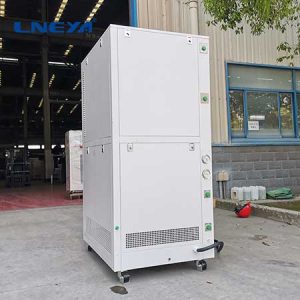What are the operating steps of the low temp chiller?
1. Add non-freezing liquid (non-freezing liquid that does not solidify at – 50 ℃) into the storage tank of FL +5°C ~ +35°C Refrigeratori d'acqua, about 100mm from the tank edge.

2. Press the power supply of the low temperature cooler, and press the power button. The display panel displays the cooling outlet temperature.
3. Set the temperature you need according to the setting method.
4. Press the refrigeration switch, and the compressor will start to work after a three-minute delay.
5. Open each valve, press the switch of the circulating pump, and the circulating pump will start to work to make the temperature in the storage tank uniform.
6. After a period of time, when the displayed temperature reaches the required temperature, other work can be started. The equipment can automatically control the temperature.

7. After the work is finished, turn off the refrigeration switch first, and then turn off the circulating pump switch after stopping for 2~3 minutes, and then pull down the switch of the main power supply.
8. When the ambient temperature is less than 5 ℃ and the machine is shut down for a long time, the non-freezing liquid (especially the water with large composition) of the circulating pump and the plate-type heat exchanger must be drained to prevent the circulating liquid from freezing and damaging the equipment.
Operation and inspection:
1. Confirm that the energy regulation is at the 0 position.
2. Press the oil pump start button, and the oil pump will start first, delaying 50 seconds. When the oil pressure reaches normal, the main engine will start, and the suction stop valve (the first start) will be opened in time to keep the suction pressure within the normal range.

3. Adjust the oil pressure to 0.3Mpa higher than the exhaust pressure.
4. After the compressor speed reaches normal, operate the energy regulating valve and slowly open the liquid supply valve in front of the shut-off valve according to the suction pressure of the compressor, so that the energy can be adjusted to 0% – 100% or equivalent load position.
5. Check whether the pressure of suction and exhaust oil is within the normal range.
6. Observe the opening status of all valves and check whether the pipeline valves have leakage (a small amount of oil leakage is allowed for the compressor and oil pump shaft seals).
7. Observe the vibration and noise of the machine.
8. Check the cooling water and refrigerant water system.
9. Observe whether the motor current is normal. Note: When the suction pressure of the compressor is high, the suction stop valve should be opened slowly so that the load does not exceed the maximum allowable load of the motor.
 LNEYA
LNEYA
 简体中文
简体中文


















































































